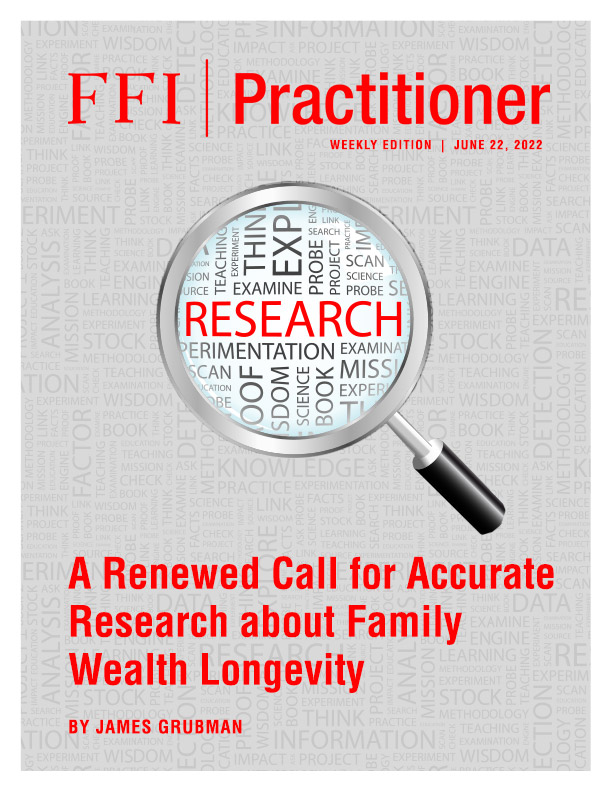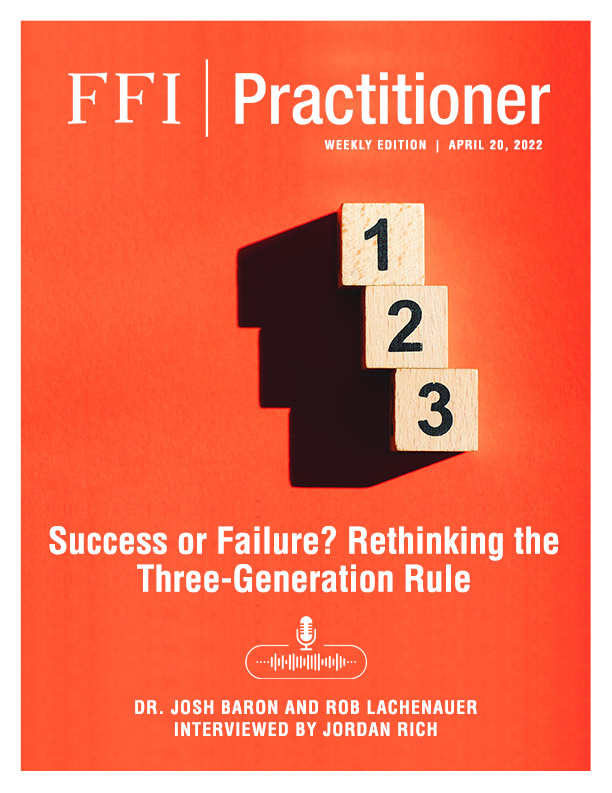
From FFI Practitioner
This week’s FFI Practitioner comes from Jim Grubman, FFI Fellow and family wealth consultant. In his article, Jim considers the origins of the “three-generation rule,” the ways this axiom has been repeated and used by wealth consultants, and the research that has followed in its wake.
Sitting next to me during a break in a family meeting, this normally cheerful, thoughtful elder commented about how much he worries that “none of them seems to have that ‘fire in the belly’” that he felt was crucial for keeping the family wealth going. Although I have often heard this concern or its kissing cousin—“How do my grandkids ‘stay hungry’ so they don’t take things for granted?”—I knew from working with his family that his offspring were actually kind, thoughtful, motivated people devoted to strengthening the legacy he had worked so hard to create. We were making good progress on governance and family communication, and none of the G2s or G3s were over spenders. All this good work was wrestling with something even stronger in his head. I asked him, “What makes you worry about that?”
He turned to me with some surprise. “Well, you know. Over 70% of wealth transfers fail by the second generation. It’s a known fact. Even if we make it to G3 and all our wonderful plans, the odds are still against us. Right?”
What We Have Been Told and What We Repeat about Wealth Across Generations
In the last few decades, the family enterprise field has made tremendous progress in our understanding of family enterprises and the wealth they can create. Yet, there are lingering areas where we need more rigor and solid research to inform our work with clients. One crucial area is in our understanding of family wealth longevity.
Several recent professional articles have increasingly called into question the ubiquitous “shirtsleeves to shirtsleeves in three generations” proverb, as well as the study by John Ward and associates (1987) providing statistics on family business longevity.2 Except for its still-frequent repetition in popular and professional writings, the 30%-13%-3% decline in longevity of family businesses has largely been dispelled using more thorough research. Stimulated by a thoughtful, articulate call within FFI for replication using better research design,3 a carefully crafted study by Thomas Zellweger and associates in 2011 produced much more positive and valid results to help us further develop our analysis and conceptualization of longevity.4
What lives on is what preoccupied Grandpa: the oft-repeated statistic that 70% of wealth transitions typically fail by the second generation.5 A methodical tracing of citations—verified by reviewing the original sources to see what was actually said—unearthed a surprising finding. The supposedly universal 70% rule derives primarily from the Ward (1987) study: a 70% failure rate of family businesses is simply the inverse of a continuity rate of 30%. There is no other substantiated evidence, only anecdotal comments by early family business consultants.
Sidebar
FFI Practitioner
How Do We Answer the Question about Wealth Longevity?
Without our longstanding “statistics” to fall back on, we and our clients are still left with the very legitimate underlying question: what does happen to wealth across generations? Here are some thoughts outlining recommendations for stronger, more useful studies about family wealth longevity:
- The research objective must be clearly defined as investigating what happens across generations to the family wealth, not to the family business. Conflating the two muddies the picture. Although the family business is often the driver of significant wealth creation, many families build wealth as high-earning professionals or through skillful investment or financial windfalls. Wealth may also continue long after a liquidity event removes the original operating company from family control, altering the paths of future generations. Family wealth and family business are not synonymous, nor is it guaranteed that the processes impacting one are identical to the other. We need clarity in studying what happens to family wealth, perhaps with and without family business as an independent variable.
- Valid longevity studies must necessarily be longitudinal, following cohorts over a long period of time, rather than using single assessments or retrospective analyses prone to hindsight bias and error. Although understandably difficult to implement, longitudinal research is nevertheless a mainstay of many professional fields that need to answer long-term questions. Family wealth advising needs to secure the funding and robust planning required for potentially decades-long research. Only then will we get the accurate data we need in our work with families who are multigenerational themselves.
- Our field’s traditional reliance on simplistic measures of “success” or “failure” may not reflect the diverse range of outcomes for families of wealth across time. Squeezing the complexity of multigenerational wealth into only two outcomes inevitably compromises research design and assessment. It may be more useful to study the long-term patterns of wealth transition in families. We could then determine the major factors, chronologies, and inflection points that could potentially serve as course corrections for families to stay on track.
- The early days of research in our field were noble in their intent but were frequently lacking in sophisticated research design. Going forward, research protocols will need to employ well-validated measures, appropriate statistical analyses, and careful avoidance of artifacts or biases that impact the findings. This will be particularly important for longitudinal studies that risk embedding errors into a lengthy project.
- More attention should be given to the sample cohorts being studied. “The wealthy” are not a homogeneous population. What happens over time to a family with US $10 million in investment assets may be very different than a family with US $200 million largely in real estate. Respondents may need to be drawn from wealth segments ranging from the mass affluent (US $1 million to US $5 million), high-net-worth (US $5 million to US $30 million) and ultra-high-net-worth (US $30 million to $500 million+) ranges. There may very well be different patterns of wealth longevity at different levels of wealth.
Research cohorts should also be representative of the demographics of the current wealth population. Many early studies relied on a wealth-creating demographic born more than a hundred years ago, around the turn of the 20th century. Not only did those generations have specific views on family communication and collaboration, but family wealth advising didn’t yet exist as a field to help guide their transitions. Studying today’s global world of wealth requires a wide range of family types and constellations, including blended and nontraditional families with leadership by each gender and with appropriate cross-cultural sampling.
Building the Research Base of Tomorrow
As I explained to the wonderful patriarch that what he had long been told was not as certain as it seemed, he visibly relaxed. He now had room in his heart for the possibilities we were building. His experience reinforced that, as a professional field, we have a responsibility to ensure that what we say can be trusted when important decisions are on the line. We must commit to responsible, well-grounded information and empirically derived research to address the deep questions families have about their very future. In doing so, we will strengthen our understanding of wealth longevity for the complex, diverse families of today and tomorrow.
References
1 The author wishes to thank Dennis Jaffe, Kristin Keffeler, Pramodita Sharma, Judy Green, Dan Frosh, and James Coutre for their invaluable input on earlier drafts of this article.
2 Josh Baron and Rob Lachenauer (2021), Do most family businesses really fail by the third generation? Harvard Business Review, July 19; Matthew Halliday, “Time to set fire to ‘shirtsleeves’ adage about family wealth, advisors say.” Canadian Family Offices online, May 1, 2022. See https://canadianfamilyoffices.com/fundamentals/time-to-set-fire-to-shirtsleeves-adage-about-family-wealth-advisors-say; John L. Ward (1987), Keeping the Family Business Healthy: How to Plan for Continuing Growth, Profitability, and Family Leadership. San Francisco: Jossey-Bass.
3 https://my.ffi.org/general/custom.asp?page=2011LongevityStudy
4 Thomas M. Zellweger, Robert S. Nason, and Mattias Nordqvist (2011), From longevity of firms to transgenerational entrepreneurship of families: Introducing family entrepreneurial orientation. Family Business Review, 20(10), pp. 1 – 20.
5 For further examination of this topic, see James Grubman (2022), There is no 70% rule: Improving outcome research in family wealth advising. International Family Offices Journal, Vol. 6, June. pp. 33-38.



